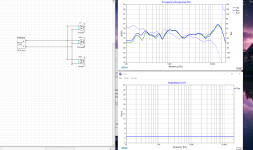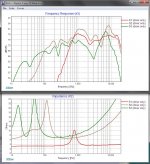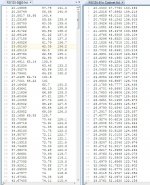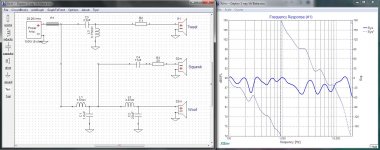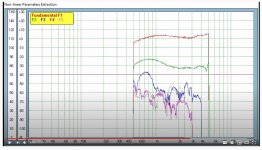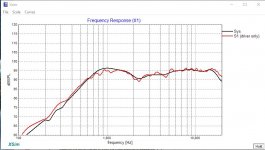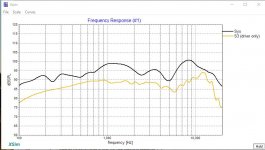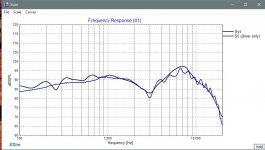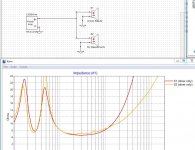I'm missing something in the measurement process. When I take measurements in ARTA
SPL levels are recorded below 0dB levels. FRD files are written from these measurements with below 0dB levels. The spreadsheets and crossover software works with levels around 60 - 100dB. How are these levels accurately adjusted?
SPL levels are recorded below 0dB levels. FRD files are written from these measurements with below 0dB levels. The spreadsheets and crossover software works with levels around 60 - 100dB. How are these levels accurately adjusted?
When I take measurements in ARTA
SPL levels are recorded below 0dB levels.
What do you get if you use just an ordinary microphone plugged into the sound chip in your computer?
Did you forget to set your USB mic as the default input device?
Last edited:
I'm getting perfect looking audio signals. This is just the levels the software graphs at. I found another tutorial explaining the need to add a set value to all the measurements. How to make a FRD file - using ARTA software | Audio Judgement
I'm getting perfect looking audio signals. This is just the levels the software graphs at. I found another tutorial explaining the need to add a set value to all the measurements. How to make a FRD file - using ARTA software | Audio Judgement
Oh my ... nothing like making it obvious... 😕
As a sometimes coder, I do wonder why they wouldn't have a configuration item to add an offset when writing files.
When I came up with the frd file format it was only to hold data. Levels can be set elsewhere by performing transforms. IIRC ARTA can do this.
I'm missing something in the measurement process. When I take measurements in ARTA
SPL levels are recorded below 0dB levels. FRD files are written from these measurements with below 0dB levels. The spreadsheets and crossover software works with levels around 60 - 100dB. How are these levels accurately adjusted?
I think the low levels depend on the microphone SPL calibration in ARTA. I had the same problem, but if I remember correctly, I think I just put some values there to get it to 'normal' levels.
I think I've finally managed to get some response measurements that are worth using. Now I'm trying to figure out the acoustic offsets using XSim. Does the port throw these measurements off? I'm not really getting anything close to what we calculated. High frequency and low frequency don't really match between the system response and my measurement of all three drivers.
Attachments
I'm attaching the driver-only SPL and Impedance plots from XSIM
I still have @JReave's coil offsets plugged in... Tweeter = 0, Mid = .94 and Woof = 3.33.
I'm also including a comparison between the factory FRD for the woofer and yours ... The levels you measured seem awfully low...
If you can confirm these are right, I'll plug it into my design and see what I can do.
I still have @JReave's coil offsets plugged in... Tweeter = 0, Mid = .94 and Woof = 3.33.
I'm also including a comparison between the factory FRD for the woofer and yours ... The levels you measured seem awfully low...
If you can confirm these are right, I'll plug it into my design and see what I can do.
Attachments
Last edited:
The SPL levels of my measurements are going to be off, but they should be fairly accurate in relation to each other. ARTA set the clipping level of my microphone at 0 dB. My nearfield measurements were around 0dB and my farfield measurements worked out to be around - 30dB so I added 100dB to all measurements to get them in a usable range for all other software. I likely could have added a couple more dB to get them closer to actual real world numbers. It looks like I have something messed up on S3 though. It should be rolling off around 30 Hz. I'll try to blend the response again to see if I can get some better results.
jReaved was recommending some lower crossover points so the drivers would be operating in ranges where they produced less distortion. "The tweeter is capable of a lower xo point and the mid is probably best with one too. I would probably try out LR2 acoustical at 300-400Hz for the lower xo point and maybe LR4 acoustical at about 2000-2300Hz." I messed around with your design for a while last week to try to get it to those points, but the tweeter wasn't cooperating at all.
I haven't done anything with baffle step or diffraction. Do these show up in the actual measurements or do I need to add some compensation for these yet? I saw here was a section for this in the FRD Response Blender spread sheet but it said this wasn't required if my measurements included these. I assume my farfield measurements do contain these, but my nearfield wouldn't.
jReaved was recommending some lower crossover points so the drivers would be operating in ranges where they produced less distortion. "The tweeter is capable of a lower xo point and the mid is probably best with one too. I would probably try out LR2 acoustical at 300-400Hz for the lower xo point and maybe LR4 acoustical at about 2000-2300Hz." I messed around with your design for a while last week to try to get it to those points, but the tweeter wasn't cooperating at all.
I haven't done anything with baffle step or diffraction. Do these show up in the actual measurements or do I need to add some compensation for these yet? I saw here was a section for this in the FRD Response Blender spread sheet but it said this wasn't required if my measurements included these. I assume my farfield measurements do contain these, but my nearfield wouldn't.
The SPL levels of my measurements are going to be off, but they should be fairly accurate in relation to each other. ARTA set the clipping level of my microphone at 0 dB. My nearfield measurements were around 0dB and my farfield measurements worked out to be around - 30dB so I added 100dB to all measurements to get them in a usable range for all other software.
If you were clipping your microphone, it is likely the measurements will be off by the amount of clipping as well as the actual levels in far field.
It would probably be better to get below -10db and then add 110db to your files...
When I measure with my spectrum analyser, I typically capture curves at about -20 db ... which works out to about 40db accoustic. This is one case where loud doesn't make us proud.
jReaved was recommending some lower crossover points so the drivers would be operating in ranges where they produced less distortion. "The tweeter is capable of a lower xo point and the mid is probably best with one too. I would probably try out LR2 acoustical at 300-400Hz for the lower xo point and maybe LR4 acoustical at about 2000-2300Hz." I messed around with your design for a while last week to try to get it to those points, but the tweeter wasn't cooperating at all.
A sure sign your target points were wrong. If you have to massively manipulate a driver to get it working, both the efficiency of the crossover and that of the entire speaker will suffer.
And just how much distortion are we talking about? Most speakers, being imprecise mechanical devices, produce some pretty nasty distortion... 10% is no surprise at all. Plus, distortion tends to rise with output, the harder you drive them the worse it gets.
I haven't done anything with baffle step or diffraction. Do these show up in the actual measurements or do I need to add some compensation for these yet?
These should show up in your measurements.
I'm attaching version 6 of the design, based on your current measurements. The large difference between the default parameters and yours is a bit concerning but as you can see, it can still be gotten to within 4 db ....
Attachments
Last edited:
I wasn't clipping my microphone. The highest level I recorded was -5dB briefly in the midrange nearfield measurement.
jReave's recomendations were here. Crossover Critique His info on the tweeter was actually for an older version of this tweeter though.
jReave's recomendations were here. Crossover Critique His info on the tweeter was actually for an older version of this tweeter though.
I wasn't clipping my microphone. The highest level I recorded was -5dB briefly in the midrange nearfield measurement.
That's good.
Well version 6 is up there, I edited into my last message. It's not a flaming disaster but I'm thinking we might do better...
Let me mull it over a bit...
Here's a video of some measurements of this tweeter. YouTube The guy didn't mind the tweeter when first measuring it, but in later videos didn't really like it after all.
I think 2 things ...
1) Is there any chance of swapping out that tweeter for something else?
2) Have you contemplated making this a 2.5 way system?
3) With respect ... I don't have a very high confidence in the measured responses. I can't help thinking something is amiss.
Lets see what @JReave has to say...
Last edited:
Well.... I don't know Arta so I can't help with any of its particulars.
But let's look at the measurements vs the sims. In each pic below, black is the simmed response and the other curves are your measured responses. Both the tweeter and the woofer are almost bang on which is excellent. That says you are doing everything right for those 2 drivers.
But the mid is a different story. It's off 4-5dB around 1-2kHz and at the top end, as well as being about 6dB too hot overall. So maybe it's the driver or maybe it's some bad reflections from the very close mid chamber rear wall but the 6dB extra in overall SPL is hard to explain. It suggests measurement error to me. I'd go another round or 2 of measuring (even tho it may be driving you nuts at the moment) and see if anything changes. Repeatability is a sign that it's probably correct. Or unfortunately that you're making the exact same error each time......😀
But let's look at the measurements vs the sims. In each pic below, black is the simmed response and the other curves are your measured responses. Both the tweeter and the woofer are almost bang on which is excellent. That says you are doing everything right for those 2 drivers.
But the mid is a different story. It's off 4-5dB around 1-2kHz and at the top end, as well as being about 6dB too hot overall. So maybe it's the driver or maybe it's some bad reflections from the very close mid chamber rear wall but the 6dB extra in overall SPL is hard to explain. It suggests measurement error to me. I'd go another round or 2 of measuring (even tho it may be driving you nuts at the moment) and see if anything changes. Repeatability is a sign that it's probably correct. Or unfortunately that you're making the exact same error each time......😀
Attachments
Well.... I don't know Arta so I can't help with any of its particulars.
Trying to help out, I installed ARTA on my machine and spent some time with it... That is some seriously weird software.
When testing and tweaking I've always used Room EQ Wizard. It gives me pretty much everything I need... and it will export FRD files that XSim loads flawlessly.
Diving deeper into the instructions last night I discovered that as well as doing SPL testing it's fairly easy to set it up to do Impedance testing as well. While this isn't something I've worried about in the past, except for keeping it within safe limits, I also discovered that REW will write ZMA files too.
I use a calibrated condenser mic for my testing. REW thinks it's a C weighted SPL meter... REW recognises USB mics as well.
The way I test driver responses is to place the microphone about an inch in front of the speaker baffle, aimed dead centre with the driver I'm testing. The others are covered or disabled. Then I put a blanket over the whole thing and run gated scans with REW. It's all done in place in the client's listening room at very low power, way less than a watt. Then in REW I adjust the measured SPL to match the driver's sensitivity and export the measurement to a text file and so far the results have been perfectly adequate for use in XSim.
To be fair... I've never used this in design phase measurement, but I don't see how it would be much different.
So now I'm wondering if this might not be a better choice for Jeff to do his testing.
Last edited:
I'm thinking I have the whole measurement thing messed up. What software do most people use? ARTA does lots, but I really don't need it to do much other than record and gate some of the measurements if I understand correctly.
I've done some comparisons between my ZMA files (Measured with DATS V3) and what Unibox spits out and they seem to be pretty similar leading me to think my bass response should also be similar to the simulations, otherwise impedance curves should move. Also the way the driver rattles your guts around 30 Hz suggests it's performing well there, but my measurements show otherwise leading me to believe they aren't good.
I've done some comparisons between my ZMA files (Measured with DATS V3) and what Unibox spits out and they seem to be pretty similar leading me to think my bass response should also be similar to the simulations, otherwise impedance curves should move. Also the way the driver rattles your guts around 30 Hz suggests it's performing well there, but my measurements show otherwise leading me to believe they aren't good.
Attachments
I don't have any treatment for reflections or stuffing in the cabinet yet (didn't want to crap it up with dust and over-spray). Reflections are quite possibly throwing off mid-range measurements. The mid chamber is still a bit too large as well, I left some room to adjust it and add some shapes to calm reflections. I'll jamb some temporary treatment behind the driver and see if that helps.
I use REW. It's been a while so hard to remember, but I'm ptretty sure I looked at Arta as well and thought that REW was the easier of the 2.
Re zma's - Unibox or any other modeling program will be pretty close to correct in the frequency range that the box affects, ie. below 100Hz here, but it very rarely gets the rest correct. I mentioned this in the sim process in post #72 - the upper range of the modeled zma file needs to be modified to match the spec sheet measurement.
I'm going to disagree that you have the measurement thing wrong. The fact that your tweeter and woofer measurements look totally accurate suggests otherwise. Something tho went wrong with mid. I think. Unless you have a very screwy mid.
For blending, yes, baffle effects should be included in the nearfield measurement. They should already by definition be included in the farfield measurement. Then you blend them together where they best match in the region of frequency overlap, in which both FR's should include baffle step loss. I admit that one was a little tough to grasp in the beginning for me too.
Re port measurements - for the purposes of the xo, you usually don't actually need to include the port measurement because one sets the speaker sensitivity by using the woofer level at about 200Hz. And this level is usually above the contribution of the port. Certainly so in the case of the RS225.
Re box stuffing - you should actually take the measurements with the stuffing you will be using in the end. If you are doing anything anywhere to affect the FR, do it before you take the measurements. That's the purpose of them - to get all the pertinent data into the FR and the zma files. And don't worry, your mid chamber isn't too big. In fact I would be worrying about the opposite - not enough room to kill rear wave energy and reflections.
Re zma's - Unibox or any other modeling program will be pretty close to correct in the frequency range that the box affects, ie. below 100Hz here, but it very rarely gets the rest correct. I mentioned this in the sim process in post #72 - the upper range of the modeled zma file needs to be modified to match the spec sheet measurement.
I'm going to disagree that you have the measurement thing wrong. The fact that your tweeter and woofer measurements look totally accurate suggests otherwise. Something tho went wrong with mid. I think. Unless you have a very screwy mid.
For blending, yes, baffle effects should be included in the nearfield measurement. They should already by definition be included in the farfield measurement. Then you blend them together where they best match in the region of frequency overlap, in which both FR's should include baffle step loss. I admit that one was a little tough to grasp in the beginning for me too.
Re port measurements - for the purposes of the xo, you usually don't actually need to include the port measurement because one sets the speaker sensitivity by using the woofer level at about 200Hz. And this level is usually above the contribution of the port. Certainly so in the case of the RS225.
Re box stuffing - you should actually take the measurements with the stuffing you will be using in the end. If you are doing anything anywhere to affect the FR, do it before you take the measurements. That's the purpose of them - to get all the pertinent data into the FR and the zma files. And don't worry, your mid chamber isn't too big. In fact I would be worrying about the opposite - not enough room to kill rear wave energy and reflections.
I use REW. It's been a while so hard to remember, but I'm ptretty sure I looked at Arta as well and thought that REW was the easier of the 2.
Far and away easier.
Now that I know REW can write ZMA files I feel a little project coming on... A nice little 5 or 10 watt amp, a USB sound interface, a test resistor, a mic jack and away we go... A one box testing and measuring solution.
- Home
- Loudspeakers
- Multi-Way
- Crossover Critique
